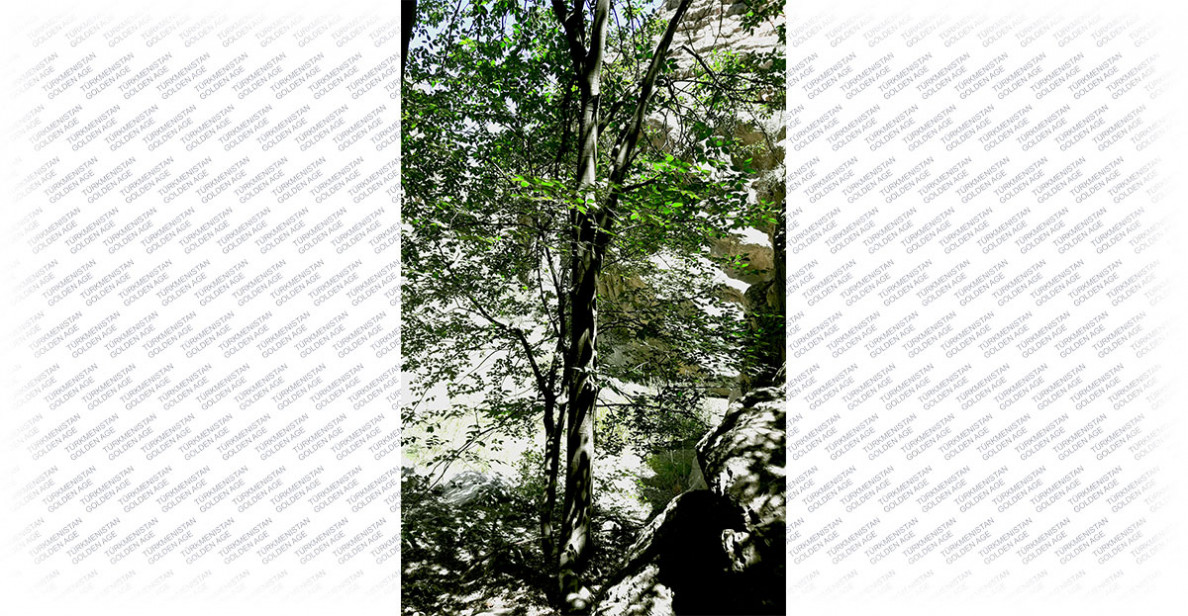The nature of Turkmenistan is rich and varied. Walking along the picturesque gorges of the Kopetdag Mountains, one often sees tall, slender trees with smooth bark and beautiful emerald foliage. This is dagdan, also called the Caucasian hackberry.
Lovers of mountain travel know that these trees grow near mountain springs, covering them with lacy shade. Dagdan grows mainly in picturesque corners of mountain gorges, where water accumulates in the depths of rocks, in crevices.
In the folklore of the Turkmen people and classical literature, these slender trees are associated with the article, power and natural beauty of mountain cliffs. The name “dagdan” can be translated as “one taking power from the mountains.”
The Caucasian hackberry is found from Eastern Turkey to the foothills of the Himalayas. Dagdan grows from the foothills to 1700-1800 meters above sea level.
Turkmenistan is located in the very center of its range. In our country, it is distributed through the territories of the Big Balkhan, Kurendag, Southwestern, Central and Eastern Kopetdag, in Badkhyz and Kugitang.
According to Guljamal Kurbanmamedova, senior researcher of the laboratory of ecology of forests and pastures of the National Institute of Deserts, Flora and Fauna of Turkmenistan, forest plantations are a natural genetic resource and a national treasure. The study of bioecological features, conservation and rational use of trees will make it possible to develop methods for their reproduction and to reveal the degree of suitability in the national economy.
In our country, a small species of the Eastern Mediterranean Caucasian hackberry (Celtis caucasica Willd), belonging to the Celtidaceae family, grows. These are deciduous trees, reaching a height of 10-15 meters. Their bark is smooth, light gray in color. These trees bloom in April-May, and the fruits ripen in autumn in September-October. Frame Caucasian drought-resistant plant, lives up to 500 years. It grows slowly, and begins to bear fruit at the age of 10–20 years.
Dagdan fruits contain up to 15% fatty oil, reminiscent of almond. They are eaten fresh or dried, or ground together with the stone into flour, from which bread and nutritious porridge “primi” is cooked. In Armenia, for the sake of fruits, the Caucasian hackberry is bred in personal plots. Leaves are fed to livestock, sometimes silkworms are fed with them. The bark contains 8–12% tannins and was used in artisanal tanning and fabric dyeing.
The wood of these trees is very hard, resilient and durable; therefore, it is called “iron” or “stone” tree. In the old days, the trunks, sometimes reaching up to fifteen meters in height, were used by people who lived in mountain villages in the construction of dwellings, using them as load-bearing beams or ceilings. The wood of these trees is used in household and carpentry work. Camel saddles, millstone handles and other household items were made from dagdan.
Since ancient times, craftsmen have made amulets of various shapes from this tree. It was believed that such an amulet is capable of averting unkind looks and attracting good luck. Miniature crafts were worn on the chest, attached to clothes and a baby cradle. Even a small saw cut of Dagdan wood is considered a talisman, such can be found above the entrance to the dwelling. It is noteworthy that many amulets made by skilled zergers from silver and inlaid with carnelian and turquoise are also called “dagdan”. Such products are inspired by original beliefs that originate in ancient ideas about the surrounding world of a sedentary agricultural population. Nowadays, frame wood is more and more used in the manufacture of souvenirs and is not used in construction and industry. Modern technologies allow replacing plant resources with artificial ones, helping to preserve natural wealth and beauty.
Ecologists of Turkmenistan attach great importance to the issues of preserving and increasing the number of green spaces. Woody species are of great practical importance and need caring attitude from a person. The Caucasian carcass is valued as a particularly drought-resistant breed, used in mountain forestry and for strengthening slopes and talus. Such plantings play an important anti-erosion role. Dagdan is one of the plants grown in protected natural zones.
Larisa Fomina
Photoes by author







